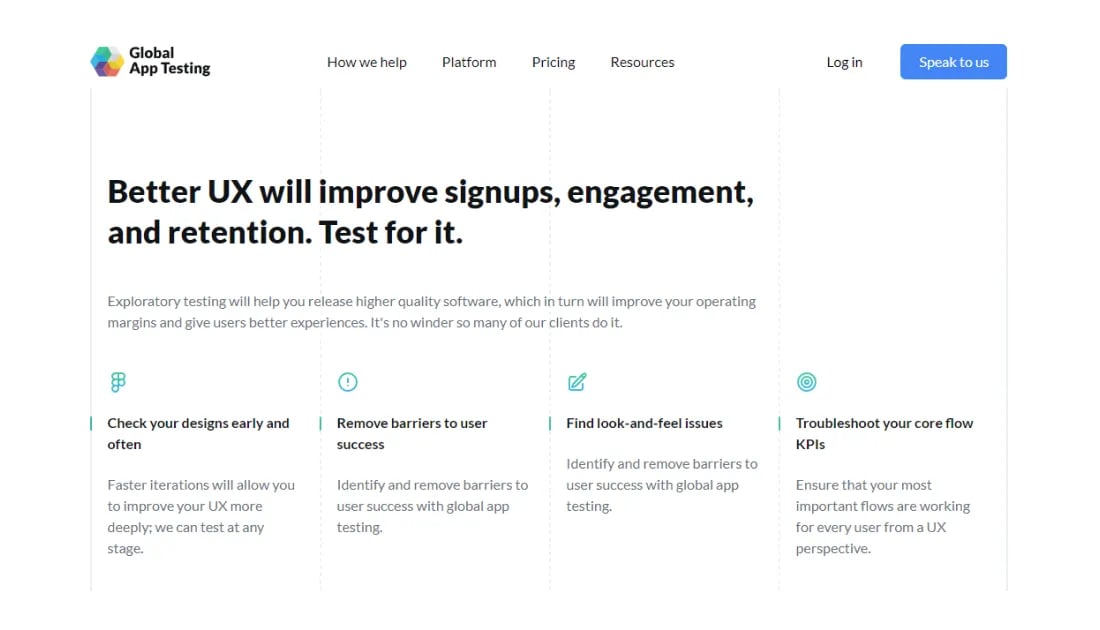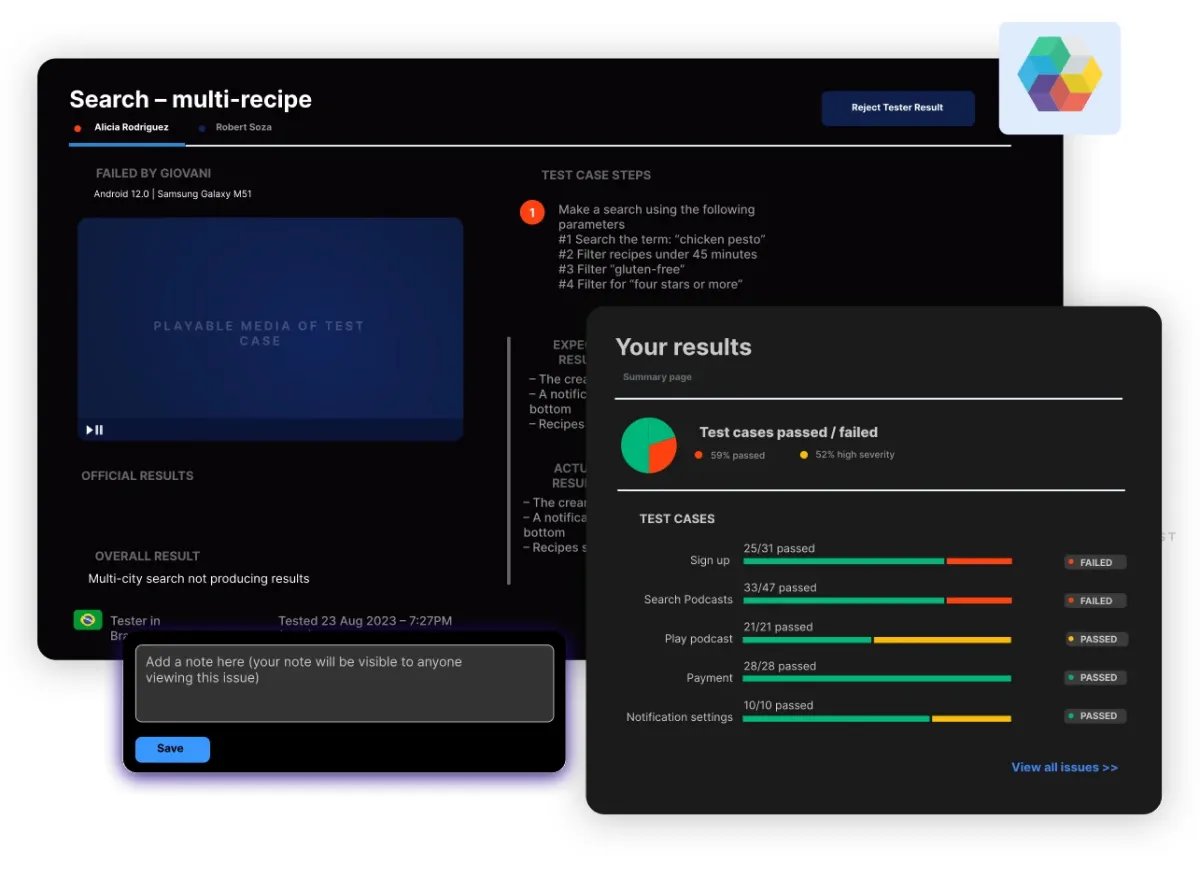10 Mobile App Testing Best Practices To Implement
Every month, over 122,000 new apps are added to the Google Play and App Store, which is quite astonishing when you consider it. With so many apps entering the market, it can be difficult to ensure quality across all devices and platforms. This is where incorporating some good best practices into your development process comes into play. It's critical for making your testing process more efficient and ensuring that your software stands out in terms of quality. We'll take a closer look at these mobile app testing best practices and see how they may greatly enhance the quality of your app. Ready to jump in?
We can help you drive global growth, better accessibility and better product quality at every level.
Why is mobile app testing important?
Mobile app testing is an important step in the development process. It ensures a high-quality mobile experience for users and helps detect issues that would go unnoticed. Below are some reasons why mobile app testing is vital:
- Improved functionality: Helps identify and fix technical glitches and ensures the app functions smoothly and as expected.
- Better user experience: Assists in detecting usability issues and enables developers to make the necessary changes to enhance the user experience.
- Cost-saving: Early detection of issues in the app helps reduce development costs.
- Increased user engagement: With proper app testing, developers can ensure that the app meets user expectations, increasing user engagement and overall app success.
- Competitive edge: An app that provides a seamless user experience can gain a competitive edge in the market, leading to business growth.
Mobile app testing challenges
While mobile app testing is crucial for ensuring that an app meets user expectations, it can also present several challenges:
- Device fragmentation: With the vast number of devices available on the market, ensuring app functionality and compatibility across all devices is a significant challenge.
- Operating system: Mobile apps must run seamlessly across different operating systems, versions, and updates.
- Network conditions: With varying network conditions, testing an app across multiple scenarios, such as 2G, 3G, 4G, and Wi-Fi, challenges app developers.
- Security: Security threats are still significant for mobile app testing. Developers must identify vulnerabilities, fix them, and implement appropriate security protocols to safeguard user data from potential breaches.
- Time constraints: Meeting tight deadlines with adequate time for exhaustive mobile app testing can present a considerable challenge.
- Cost of testing: Significant expenses may be due to the requirement for diverse hardware, software, and teams tailored to various mobile devices.
10 Mobile App testing best practices
After understanding the importance and challenges of mobile app testing, let’s see what mobile app testing best practices are.
1. Create a detailed test plan
Creating a detailed test plan is essential for successful mobile app testing, as it:
- Outlines the testing approach, scope, timeline, and test cases, ensuring thorough quality and functionality testing.
- Assists in identifying the tools, infrastructure, and resources required for testing.
- Defines each test cycle uniquely, contributing to a robust and well-tested app.
- It gives the team insight into what needs to be tested and how to mitigate issues during testing.
2. Understand your target audience
To meet users' needs effectively, testers must understand their expectations, demographics, and behaviors. With this understanding, testers can identify the critical features of the app that users want and understand what frustrates them. This knowledge helps testers to craft relevant test cases and simulate the most accurate user scenarios. It also helps to identify valuable insights into areas where the app might be lacking and gives developers the necessary feedback to make the necessary improvements.
3. Know your app
The testers must comprehensively understand the app's goals, requirements, and user scenarios. They need to identify the potential issues that may arise during app usage and test accordingly, using relevant test cases. For instance, if an app is designed to help users track their daily water intake, testers should not only check if the app records the input correctly but also consider scenarios like changing time zones or interruptions during input.
This detailed understanding ensures that testing is purposeful, with each test case contributing uniquely to enhancing the app's functionality and user experience. Additionally, being familiar with the app helps testers recognize how it interacts with other systems or platforms, including databases, back-end systems, and third-party tools, ensuring seamless integration and performance across the board.
4. Use automated and manual testing
Both automated and manual testing are essential parts of mobile app testing. Automated testing helps detect potential issues, offering quick and reliable results without human intervention. Automated testing is ideal for testing the same function repeatedly and continuously (like in regression or load testing), as it eliminates human errors and saves time that you would otherwise spend on repetitive tasks.
On the other hand, manual testing allows testers to navigate and perform complex user flows, identify user interface issues, and execute visual inspections. For example, a manual tester might simulate a user signing up for a new account on a mobile app to ensure that the sign-up process is intuitive and that all user inputs are correctly validated. The best approach is combining automated and manual testing to ensure thorough testing of mobile apps
Pro tip
Utilizing advanced software tools and technology, Global App Testing services perform various tests swiftly and effectively. With a network of 90,000 testers across 190+ countries, GAT employs automated and manual testing methods to pinpoint issues within your web or mobile application.
5. Consider usability and UI testing
Usability testing analyzes the app from a user's perspective, determining whether it is easy to use, such as manually checking if users can easily navigate through a shopping app to find and purchase products without confusion. On the other hand, UI testing analyzes the app in terms of design and user interface, like automatically verifying that all buttons are correctly aligned and responsive across different screen sizes.
With usability testing, testers identify issues related to mobile device compatibility and test scenarios and user flows. Meanwhile, UI testing ensures that the app's interface is functional, user-friendly, and meets the standards of the target audience. It helps testers identify design issues that may interfere with the user experience. Incorporating usability and UI testing in mobile app testing ensures that the app will provide the intended user experience and be adopted by users. A poorly designed and difficult-to-use app may result in negative reviews, a low adoption rate, and a failure.
Pro tip
Effective usability and UI testing involves a combination of automated and manual methods, utilizing diverse tools to encompass various user scenarios. The objective is to guarantee every user experiences a seamless and consistent interface with your web app, regardless of the device or browser used.

6. Other types of testing to consider
In addition to usability and UI testing, mobile app testing encompasses other testing practices that ensure the app works seamlessly. Some of the different types of testing to consider are:
- Functional testing checks if the app meets the requirements and intended use case.
- Performance testing ensures the app runs efficiently, testing lag time and speed, resource usage, and scalability.
- Security testing detects security vulnerabilities and provides user data is secure.
- Compatibility testing verifies the app works on different platforms, devices, and OS.
- Localization testing checks if the app functions well under different languages and local contexts.
- Regression testing ensures changes and features don't create unintended outcomes.
7. Conduct cross-platform testing
With numerous mobile devices and platforms on the market, like Android, iOS, and Windows, cross-platform testing is a critical aspect of the quality assurance process. It verifies that the app functions consistently across various devices, operating systems, and platforms. Cross-platform testing identifies essential compatibility issues such as screen size, image resolution, and aspect ratios and ensures that the app works reliably. Furthermore, it provides the developer with valuable feedback to ensure that the app works perfectly across the targeted user's devices, supporting a seamless experience.
8. Conduct connectivity-related testing
Connectivity-related testing is an essential mobile app testing practice that ensures the app works well in different network conditions. Given the rise of mobile devices and the demand for mobile internet access, connectivity-related testing checks whether the app supports different network speeds, such as 2G, 3G, 4G, and Wi-Fi. This type of testing ensures that the app is functional in different network conditions, such as low and spotty connectivity, simulating aspects such as network outages, session drops, and latency. Such testing ensures the app's consistency and reliability, allowing for optimal use regardless of location.
9. Test early and often
One essential practice is testing early and often throughout the development process. This means running tests at each stage of development to catch bugs and improve overall functionality. Testing early can identify issues that can be corrected before they become problematic, saving developers time and resources in the long run. Consistent testing can also ensure the app works seamlessly across multiple platforms and devices.
10. Keep your test data organized
Keeping testing data organized can be a challenging task. Still, it is vital to maintain an accurate and comprehensive record of every test run. This includes tracking every test scenario, the corresponding test data, and any relevant test outcomes. Efficiently organizing and managing test data can help identify and address any issues found during the testing process, improve specific functionality, and enhance overall user experience. Accurately maintained testing data can provide developers with quick and constant insights into software performance, ultimately reducing errors and helping teams establish an efficient testing workflow.

Global App Testing results example.
How can Global App Testing elevate your testing process?
Global App Testing is dedicated to ensuring the quality and performance of software products. Here's how we can support your testing needs:
1. Thorough testing coverage: We ensure comprehensive testing coverage to meet all specified requirements, leaving no aspect unexamined in our pursuit of quality.
2. Diverse testing services: Our suite includes functional, performance, security testing, and test automation, catering to diverse needs across various software domains.
3. Expert team: With a global network of 90,000 testers spanning 190+ countries, our professionals are committed to delivering high-quality solutions using the latest tools and methodologies.
4. Cutting-edge methodologies: We employ continuous integration, regression testing, and exploratory testing to ensure efficient and thorough evaluation of software products.
5. Tailored solutions: Our flexible approach allows us to tailor testing services to your unique requirements and align with specific regulatory standards for compliance and peace of mind.
Collaborate with us to gain access to top-notch expertise and resources, elevating the quality and reliability of your software products. Schedule a consultation with our team today!
We can help you drive localization as a key initiative aligned to your business goals
FAQ
1. How can I ensure thorough testing coverage for my mobile app?
To ensure thorough testing coverage of your mobile app, start with defining clear test objectives, identifying critical user scenarios, and utilizing manual and automated testing techniques to cover different aspects of the app's functionality.
2. How do I effectively manage testing across different mobile platforms and devices?
Effective management involves prioritizing testing based on market share and user demographics, utilizing cross-platform testing frameworks, and leveraging cloud-based testing services for scalability and device coverage.
3. What are the advantages of crowdtesting for mobile app testing?
Crowdtesting offers advantages such as access to diverse testing environments and demographics, scalability for large-scale testing projects, real-world testing scenarios, rapid feedback cycles, and cost-effectiveness compared to traditional testing approaches.
Keep learning
10 types of QA testing you need to know about
How to write a test strategy document for your testing
How to create a test plan for software testing in 2025

